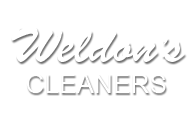FREQUENT QUESTIONS
How does the dry cleaning process work?
Weldon's Cleaners uses a high-end, non-toxic cleaning solvent
called DF2000 which is safe for you, for your clothes, and for the
environment. Environmentally friendly and a sound cleaning system
that is gentle and odorless, giving your garments a nice, soft
feel.
Regardless of the solvent used, clothes are placed into a basket similar to a washing machine; that is, the basket contains a perforated drum that rotates inside of an outer shell. During the wash cycle, new solvent is constantly fed into the machine while old solvent is removed. Afterwards, the machine will "rinse" with a fresh load of distilled solvent to help keep
the clothes from absorbing the already used working solvent. Following this, the extraction cycle will spin the basket incredibly fast to extract as much solvent as possible. Then, the drying cycle begins, which utilizes warm air to push through the clothes and thus evaporate any traces of solvent still remaining, with the temperature of air
depending on what type of garments are being cleaned. Finally, after a cooling cycle, garments are pressed and finished!
Some items may have to be pre-treated ahead of cleaning. Typically a dry cleaning solvent is used for this purpose, but because of safety concerns there
may be restrictions to that practice. For this reason, it is helpful if you know the origin
of any notable stains so we can best serve both the customer and our environment.

How do I know if my clothes need to be dry cleaned?
We talked about dry cleaning above, the alternative is called wet cleaning which is with water, typically in a washing machine. Plant-sourced products such as linen and rayon
lose quite a bit of durability when exposed to water and can easily be damaged, particularly in home washing machines which have an agitator pulling at fabric. Likewise, items from animal sources
such as wool or silk should avoid getting wet as it will reduce its life, color, and wear ability. These are all candidates for dry cleaning.
Other items are less compatible with the dry cleaning process. For example, certain plastics found in some beads and buttons can melt, and glued-on accentuations
such as faux jewels or glitter can simply detach from the garment. If you are unsure, bring it to us and we will help you decide.
CLOTHING CARE
Take the time to know the clothes you love to wear!
Most garments will contain instructions on their tags stating
whether or not they need to be dry cleaned. These instructions are
sometimes written out for the consumer, but often when
professional care is recommended you may only see symbols.
Example of tag symbols on clothing. Example of tag symbols on clothing.
In the example pictures, the first garment has an open circle indicating it can be dry cleaned. If this wasn't the case there would be an X through that circle, much like the X through
the darkened triangle (no bleach). The second garment does not have a dry cleaning circle at all, so whether it should be wet or dry cleaned would depend on other factors. A list of many
laundry symbols can be found on
Wikipedia.

What if the tag doesn't have a yes-or-no dry cleaning symbol at all?
Care Label Rule of the Federal Trade Commission states that only one suitable method of care must be specified. However, if dry cleaning is potentially detrimental to the product
the tag should inform you of that information. In cases where it isn't clear we will advise you of the risks and proceed in an agreeable manner. We may even ask you to sign a damage waiver.
View the
FTC website to find out more about the
Care Label Rule.


